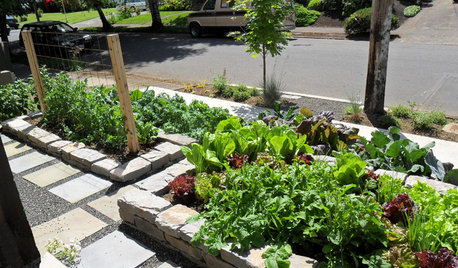Bent trees produce more fruit?
clarkinks
9 years ago
Related Stories

GARDENING GUIDESGreat Design Plant: Grow Blueberries for Their Fruit and More
Eastern gardeners should consider growing blueberry plants for their delicious fruits, bee-friendly spring blooms and brilliant fall foliage
Full Story
EDIBLE GARDENSHow to Grow 10 Favorite Fruit Trees at Home
Plant a mini orchard in fall, winter or early spring to enjoy fresh-off-the-tree fruit the following year
Full Story
GARDENING AND LANDSCAPINGCrazy for Fruit Trees
Whether a single citrus or a mini apple orchard, even the smallest landscape space can bear deliriously delicious fruit
Full Story
FARM YOUR YARDIf You Have Room for Only One Fruit Tree ...
Juice up a small garden with one of these easier-care or worth-the-effort fruit trees for a mild climate
Full Story
GARDENING GUIDESHow to Keep Your Citrus Trees Well Fed and Healthy
Ripe for some citrus fertilizer know-how? This mini guide will help your lemon, orange and grapefruit trees flourish
Full Story
FALL GARDENING5 Fall Fruits You Can Grow in Containers
Brighten your porch or patio with a potted pomegranate, kumquat, blueberry bush or another great fall fruit
Full Story
MOST POPULARHow to Get Rid of Those Pesky Summer Fruit Flies
Learn what fruit flies are, how to prevent them and how to get rid of them in your home
Full Story
FRONT YARD IDEASWelcome Edibles Into the Front Yard for Fresh Food and More
Give your front yard design a boost and maybe even make new friends by growing fruits and vegetables
Full Story
EDIBLE GARDENSWhy Grow Quince? For Beauty, Fragrance and Old-Time Flavor
Delightfully perfumed fruit and lovely spring blossoms make this apple and pear cousin worth a spot in the garden
Full Story
EDIBLE GARDENSHow to Add an Apple Tree to Your Edible Garden
Readily available, beautiful and fragrant, apple trees offer four-season interest along with crisp, juicy fruit
Full StoryMore Discussions








Scott F Smith
clarkinksOriginal Author
Related Professionals
Wrentham Landscape Architects & Landscape Designers · Elwood Landscape Architects & Landscape Designers · Brooklyn Center Landscape Architects & Landscape Designers · White Oak Landscape Architects & Landscape Designers · Addison Landscape Contractors · Canyon Lake Landscape Contractors · Cicero Landscape Contractors · Flagstaff Landscape Contractors · Fort Atkinson Landscape Contractors · Lady Lake Landscape Contractors · Norristown Landscape Contractors · Pleasanton Landscape Contractors · Tustin Landscape Contractors · Westchester Landscape Contractors · Silver Firs Landscape Contractorsalan haigh
fruitnut Z7 4500ft SW TX
clarkinksOriginal Author
tete_a_tete
clarkinksOriginal Author
alan haigh
olpea
alan haigh
alan haigh
fruitnut Z7 4500ft SW TX
olpea
alan haigh
nyRockFarmer
fruitnut Z7 4500ft SW TX
alan haigh
olpea
fruitnut Z7 4500ft SW TX
olpea
alan haigh
nyRockFarmer
olpea
rayrose
olpea
alan haigh
rayrose
drew51 SE MI Z5b/6a
alan haigh
olpea
alan haigh
olpea
drew51 SE MI Z5b/6a
alan haigh
clarkinksOriginal Author